Visual Scanning is a component of visual processing that is crucial to everything we do! From taking in visual information, to using that information in making decisions and enabling actions…visual scanning is an oculomotor skill that is sometimes an area of difficulty for those struggling with visual processing skills.
Below, you will find information about visual scanning, including what this oculomotor control component looks like, what visual scanning really means, and why scanning as a visual skill is needed for learning, functional tasks, social emotional skills, executive function and other cognitive abilities, and just about everything we do!
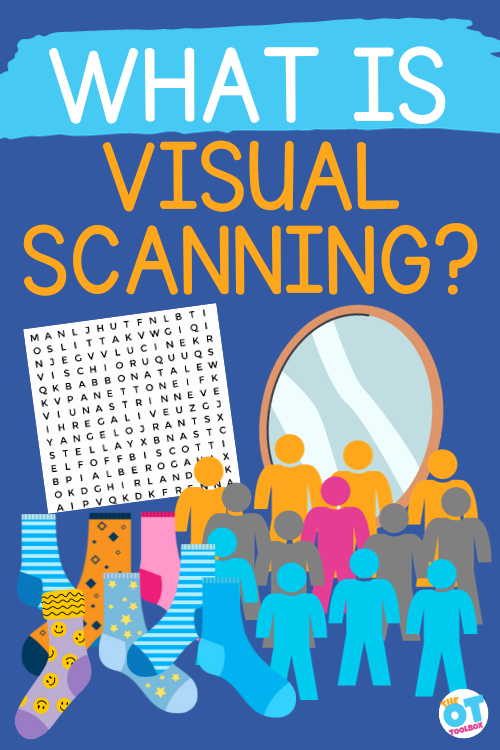
To work on visual scanning in the classroom or clinic, you may want to grab this free 17 page visual perception worksheet packet that promote oculomotor skills like visual scanning as well as visual perceptual skills!
What is Visual Scanning?
Visual scanning is an aspect of visual processing that impacts daily functional tasks, learning, safety, and everything we do. Visual scanning looks like…
- Visual scanning is noticing a car parked on the corner when you try to cross the road.
- Visual scanning is finding last night’s homework in a cluttered backpack.
- Visual scanning is locating a matching shoe in a bin at the bottom of the closet.
- Visual scanning is finding a pair of pants in a dresser to wear on a cool day.
- Visual scanning is setting the table.
- Visual scanning is looking for a lost parent on a busy playground.
- Visual scanning is doing a word search puzzle.
- Visual scanning is copying homework from the board and moving the eyes back to the place on the paper every time the eyes shift from the board to the paper.
- Visual scanning is leaving a crowded place to find a bathroom, searching for the restroom in a hallway, finding an open stall, searching for the soap dispenser location, identifying where the paper towel dispenser or air dryer is in the restroom, searching your face and image in the mirror for anything out of place, and then back in the crowded space, locating your loved ones in the crowd.
Visual scanning is a lot of things! Rather, visual tracking is USED and REQUIRED in a lot of tasks. Scanning is needed to be independent, stay safe, make decisions, stay organized, help others, be a vital part of a workplace, succeed in school, learn and grow as an individual, and SO much more!
Many of these tasks are automatic and we scan our eyes, filter out information, and identify what we are looking for without even thinking about it.
Oculomotor Control
Visual Scanning is a part of the oculomotor system that allows the eyes to take in information. Here is more information on oculomotor dysfunction and activities that can help address this area. Scanning makes up a piece of the visual-receptive components of the visual system.
The oculomotor control that allows us to take in information includes visual pursuit, or tracking, and saccadic eye movements, or scanning. The muscles of the eyes control these movements in a voluntary and reflexive capacity.
saccades and Visual Scanning
A visual saccade is the movement of the eye toward visual stimuli. This movement of the eyes in visual scanning allows the eyes to focus on the most important part of the visual stimuli.
This allows us to notice a specific word, phrase, or topic in a body of text. You can see how scanning is needed for reading comprehension and writing essays in the school environment. In fact, visual scanning is a part of reading difficulties.
Check out this resource for more information and specific scanning activities for reading.
Visual Scanning Looks Like…
That precise focus of our eyes on a warm pair of clothes hidden in a closet provides safety and important information to drive executive functioning and decision-making.
The ability of they eye to focus on detail allows us to notice and locate our lost child in a busy store. These motor actions of the eyes are happening with both intention and in an automatic way so we are safe, locating the visual information we need, and safe.
At the same time, unnecessary information is negated, allowing the information we are looking for to be received and therefore processed for use in visual motor tasks, eye hand coordination, and function.
Here are activities to improve visual saccades.
Visual Scanning and Visual Perception
You can see how scanning works together with visual perception. As we scan, we need to discriminate, pull out the necessary information from background information, utilize visual closure, and sustain visual attention.
Visual discrimination is one key component. This requires visual perceptual skills of visual figure ground, visual form constancy, visual memory, and other underlying skills in order to determine differences in visual input and match it to a file from the mind’s visual memory to match similarities and differences. This is true for every item that could be discriminated from others, including by classifications such as form, size, color, or other features.
Visual closure is another component of visual processing and impacts visual scanning because when we read, we automatically “close” of visualize the whole word without identifying each letter of a word. This allows for reading speed and automaticity. Then, we need to comprehend what we’ve read. For the child with visual scanning challenges, we can see difficulties with speed, comprehension, and keeping up with grade expectations as information is consumed and understood.
Visual attention is another component of visual scanning because when reading or writing, we need to attend to the location in the sentence. When copying from a model, we need to remember where we left off. This is a component of visual shift and brings us back to oculomotor skills and visual shift. Read about near point copying for more information.
Likewise, to access the information, visual perceptual skills require the ability to scan the environment.
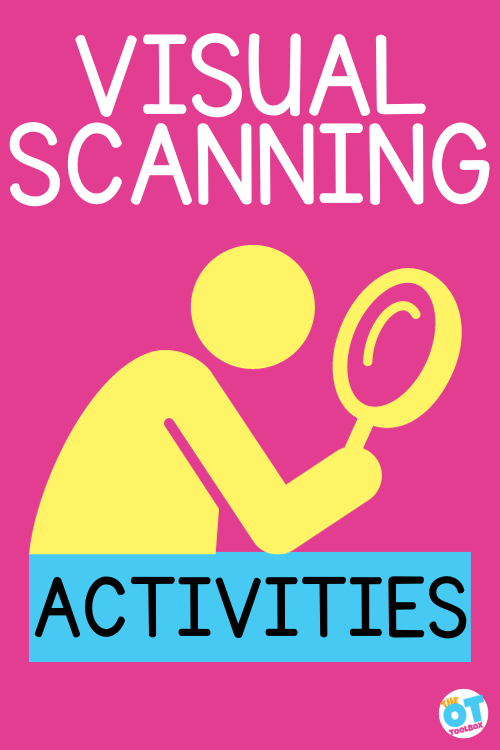
Try the visual scanning activities listed below.
Visual Scanning Activities
We love the visual scanning activities below because they are hands-on and play-based. These components make visual scanning activities fun and engaging for kids, and most importantly, meaningful for kids because of play being the primary motivator and occupation in kids.
There are many visual scanning exercises out there in the form of worksheets (and these have their place in vision therapy as well), however sometimes a play-based vision activity or a game is effective and fun in supporting visual scanning needs.
The vision scanning activities below do just that.
- Here is a visual scanning activity that includes a motor component. The eye-hand coordination couples with and requires visual scanning, visual perceptual skills, and the motor integration of that information for a task.
- This visual scanning activity is a low-prep activity that can be used with a variety of themes or to address various levels.
- For more easy activities that address a variety of visual perceptual and visual motor skills, you’ll love these visual scanning activities.
- This Bubble Wrap Math Maze is a fun way to work on visual scanning as well as other skill areas. Kids will love the auditory and proprioceptive feedback, too.
- Tangrams and finding correct pieces of puzzles like the ones tangrams support area great way to encourage visual scanning as well as the perceptual and motor components of visual processing. These Cardboard Tangrams are a frugal and fun way to play and develop skills.
- This Letter Seek and Find activity is a low-prep and quick activity that can be used with various ages and levels. Attach handwriting tasks to make it perfect for older kids. Younger kids can work on letter recognition while addressing oculomotor skills, visual perception, and motor components.
- Work on visual scanning with a tasty feedback, using letter cookies or crackers! This Letter Cookie Seek is a great way to work on the visual skills needed for so many areas.
- Look for a specific letter in a word search.
- Play I Spy with real toys spread out on a table.
- Visually scan for objects on a wall or hidden around a room like these wall bat templates where you can use a flashlight to scan for the correct bat (or use any shape or image like shapes, colors, or templates).
- Do a count and color worksheet.
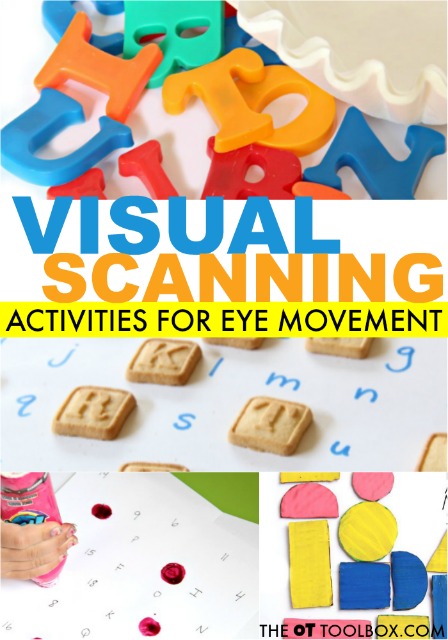
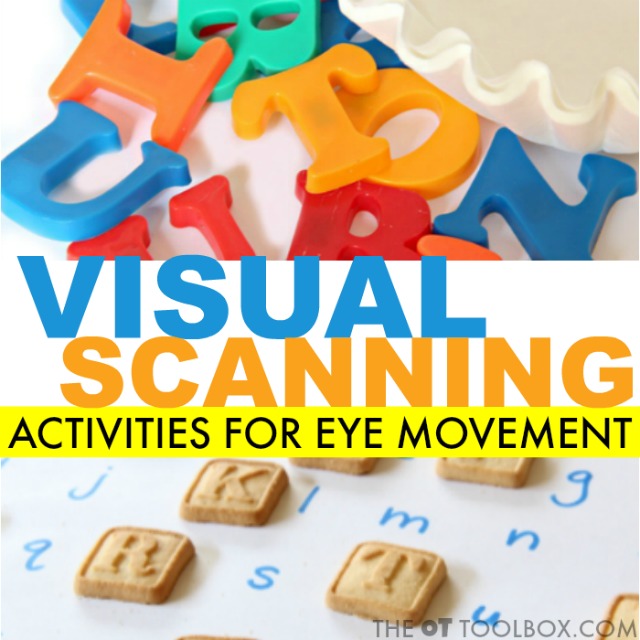
Feel free to use this visual scanning graphic on social media, and please link to this blog post for reference.
Looking for more visual scanning activities for the kids? Try some of these:
- Seek and find games such as “I Spy”. Or create your own real toy “I Spy” game.
- Roll a ping pong ball across a table from person to person. Watch it with your eyes, keeping your head still!
- Trace pictures on a light box.
- Flashlight games.
- Sensory seek and find.
More visual processing activities
For even MORE visual scanning activities to use in your occupational therapy practice, you will want to join our free visual processing lab email series. It’s a 3-day series of emails that covers EVERYthing about visual processing. We take a closer look at visual skills and break things down, as well as covering the big picture of visual needs.
In the visual processing lab, you will discover how oculomotor skills like smooth pursuits make a big difference in higher level skills like learning and executive function. The best thing about this lab (besides all of the awesome info) is that it has a fun “lab” theme. I might have had too much fun with this one 🙂
Join us in visual processing Lab! Where you won’t need Bunsen burners or safety goggles!
Click here to learn more about Visual Processing Lab and to sign up.

Colleen Beck, OTR/L has been an occupational therapist since 2000, working in school-based, hand therapy, outpatient peds, EI, and SNF. Colleen created The OT Toolbox to inspire therapists, teachers, and parents with easy and fun tools to help children thrive. Read her story about going from an OT making $3/hour (after paying for kids’ childcare) to a full-time OT resource creator for millions of readers. Want to collaborate? Send an email to contact@theottoolbox.com.


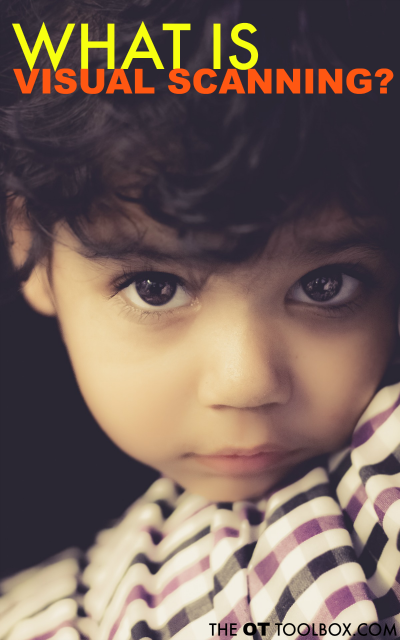
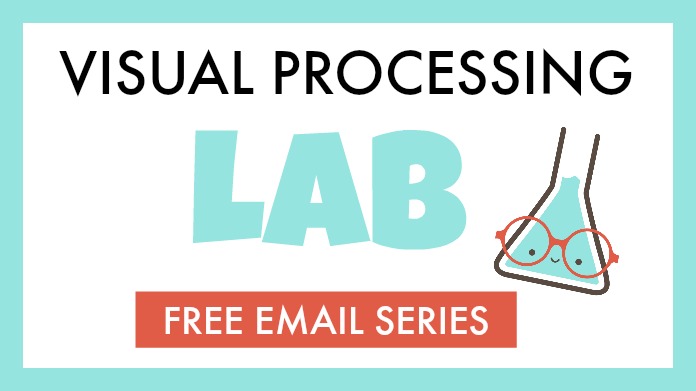






1 thought on “What is Visual Scanning”
Hello. Please note alot of the links in this post are broken. Is there a way to get them wotking? Thanks 🙂
Comments are closed.